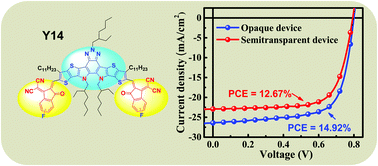Semitransparent solar cells with over 12% efficiency based on a new low bandgap fluorinated small molecule acceptor†
Abstract
Rational molecular design of n-type organic semiconductors with strong near-infrared absorption and visible-light transmittance is critical but still a challenge for application in high efficiency semitransparent organic solar cells (OSCs). Here, by employing fluorinated 2-(2,3-dihydro-3-oxo-1H-inden-1-ylidene)propanedinitrile as an end group, a fused dithienothiophen[3,2-b]-pyrrolobenzotriazole (BTA-core)-based low bandgap electron acceptor, namely Y14, has been designed and synthesized to address this issue. The BTA-core-based non-fullerene acceptor has relatively high electron mobility and a broad absorption from 300 to 1000 nm. The Y14-based single-junction opaque and semitransparent inverted OSCs achieved high power conversion efficiencies (PCEs) of 14.92% and over 12%, respectively. By further optimizing the semitransparent device with additive treatment and thermal annealing, a higher PCE of 12.67% was realized with an average visible transmittance (AVT) of 23.69%. These results demonstrate that this BTA-core-based structure toward non-fullerene acceptors is a universal strategy that is not only suitable for high efficiency OSCs, but also has great potential as an acceptor material in semitransparent devices.



 Please wait while we load your content...
Please wait while we load your content...